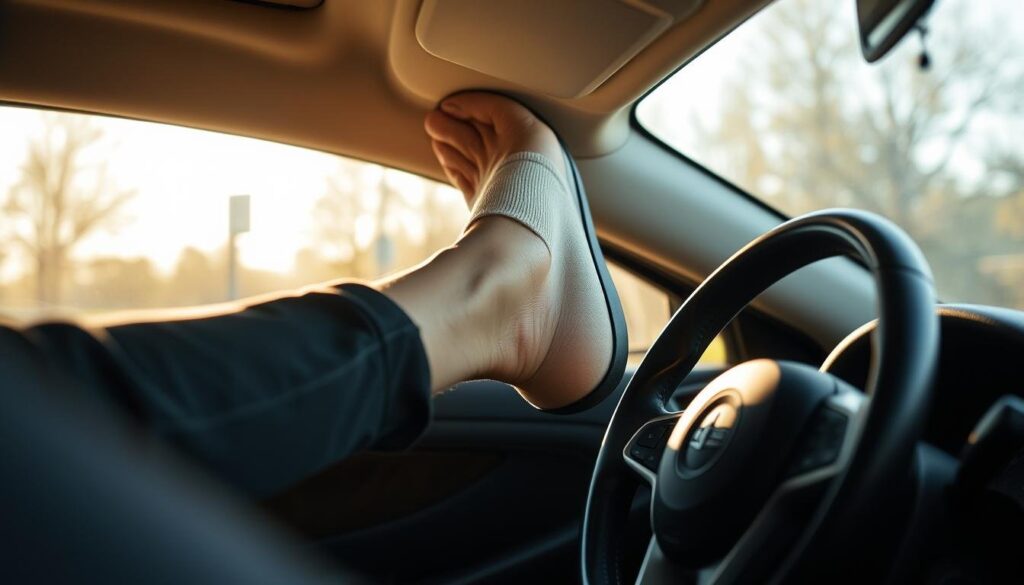Why Driving with One Foot is Better? Are you looking for a more efficient driving technique? You might have heard of one-foot driving. This method uses one foot for both the accelerator and brake pedals.
Using one foot can make driving better. It gives you more control and less fatigue on long trips. You’ll find it makes your daily drive more comfortable.
Let’s explore the benefits of one-foot driving. See how it can change your driving habits for the better.
The Traditional Two-Foot Driving Method vs. One-Foot Technique
There are two main driving techniques: the traditional two-foot method and the one-foot technique. The two-foot method uses one foot for the gas and the other for the brake. This is what most driving schools teach and is seen as the standard.
The one-foot technique, however, uses the same foot for both pedals. Its supporters say it can make driving safer by lowering the chance of pressing both pedals at once.
How Two-Foot Driving Affects Your Driving
Driving with two feet can cause problems. It might confuse you when you need to switch pedals, which could lead to accidents. Here are some key differences between the two methods:
| Driving Method | Pedal Control | Safety Impact |
|---|---|---|
| Two-Foot Method | Separate feet for accelerator and brake | Potential for simultaneous pedal pressing |
| One-Foot Method | Single foot for both pedals | Reduced risk of accidental simultaneous pressing |
The one-foot technique needs more practice but can make driving smoother. It also helps avoid getting tired on long drives. Knowing the differences between these methods helps you choose the best one for you.
Why Is It Better to Drive with One Foot?
Driving with one foot has many advantages over using two. It lets you control the car better and stay safer on the road. This method can improve your driving skills.
One big benefit of driving with one foot is better control. You can press the pedals more accurately. This reduces sudden stops or starts. It also makes your foot-eye coordination better.
Another plus of single-foot driving is less fatigue on long trips. Using one foot means less strain on your legs and feet. This makes driving more comfortable, especially on long drives.
Driving with one foot also makes you more mindful. You have to think more about your actions. This makes you safer, as you’re more ready for dangers.
In short, the benefits of driving with one foot are many. They include better control, less fatigue, and being more careful. Trying this method can make driving safer and more fun.
Safety Advantages of Single-Foot Driving
One-foot driving is more than a method; it’s a safety strategy. It lowers your chance of being in an accident. Learning this technique can make you a safer driver.
One of the main safety advantages of one-foot driving is the lower risk of accidents. Using one foot means you can’t press both pedals at once. This mistake often causes loss of control or skidding.
Reducing the Risk of Accidents with One-Foot Driving
Adopting one-foot driving can greatly lower your collision risk. It makes acceleration and braking smoother. This reduces brake wear and improves vehicle control.
- Enhanced control over the vehicle
- Reduced risk of pedal errors
- Smoother acceleration and braking
One-foot driving is also great in heavy traffic or long drives. It helps avoid driver fatigue and pedal mistakes. It keeps you focused and quick to react to surprises.
Physical Benefits for Drivers
Using the one-foot driving technique can make driving more comfortable and less tiring. It simplifies the driving process, leading to a more relaxed experience.
Some key physical benefits of one-foot driving are:
- Less strain on your legs and feet because of fewer movements
- Less fatigue on long drives, as you’re not constantly switching feet
- Improved comfort, allowing you to focus more on the road
Driving with one foot can also improve your driving habits. With fewer distractions from foot movements, you can keep a steady speed and follow traffic rules better.
By adopting the one-foot driving technique, you can enjoy these physical benefits. It makes driving more enjoyable and less strenuous.
Mastering the One-Foot Driving Technique
Learning to drive with one foot takes practice and patience. It means using one foot for both pedals. This can make driving smoother and more efficient.
To begin, adjust your seat to reach both pedals easily. You might need to change your seat or get used to a new pedal setup.
Start by practicing in an empty parking lot. It’s safe and lets you get used to the pedals. Begin with slow movements and increase your speed as you get better.
- Begin with slow movements, gradually increasing your speed as you become more comfortable.
- Practice braking and accelerating smoothly to avoid jerky movements.
- Focus on coordinating your foot movements with your observation of the road ahead.
Practice regularly to improve your skills. Consistency is key. It helps build muscle memory and enhances your driving.
Here are some extra tips:
- Keep your heel on the floor for better control.
- Use the ball of your foot for precision.
- Be patient; it takes time to master.
With regular practice, you can master one-foot driving. It will make your driving more efficient and controlled.
Situations Where Caution Is Needed
Driving with one foot can be safe and effective. But, there are times when you need to be extra careful. It’s key to know when to pay extra attention to stay safe on the road.
Driving in heavy rain or snow is one such time. Reduced traction makes it hard to control your car. Using one foot might not help you stay stable. So, you need to adjust how you drive to fit the road conditions.

Another time to be careful is in heavy traffic or construction zones. It’s hard to accelerate, brake, or change lanes with one foot. This can wear out your car’s parts or cause accidents if not done right.
To drive safely with one foot, you must watch your surroundings. Be aware of pedestrians, other cars, and road conditions. These can affect your ability to drive safely.
By being cautious and adjusting your driving as needed, you can lower risks. This way, you can enjoy the benefits of one-foot driving.
Conclusion: Why Driving with One Foot is Better?
Now you know the perks of driving with one foot. It makes your drive safer and less tiring. You’ll also find your daily trips smoother.
Driving with one foot boosts your reaction time and cuts down on fatigue. It takes practice, but it’s worth it. You’ll feel more at ease and confident while driving.
Adding one-foot driving to your daily routine is a big step towards safer, more enjoyable driving. As you keep practicing, you’ll notice how much better it makes your driving feel.
See Also: Why Is My iPhone Taking So Long To Activate eSIM?
FAQ
What are the benefits of driving with one foot?
Driving with one foot can make you safer on the road. It also helps reduce driver fatigue. Plus, it can improve your driving skills overall.
Is it difficult to master the one-foot driving technique?
Learning to drive with one foot takes practice. But with a guide and dedication, you can get good at it.
How does one-foot driving compare to the traditional two-foot driving method?
One-foot driving uses only one foot for pedals. This can make you safer and less tired while driving.
Can driving with one foot reduce the risk of accidents?
Yes, it can. One-foot driving lets you focus on the road better. You can react faster to surprises.
Is one-foot driving suitable for all drivers?
Not everyone can drive with one foot. It’s best for most drivers but not for those with physical limits or disabilities.
How can I practice one-foot driving to achieve better results?
Practice in a safe, empty area like a parking lot. Start slow and get faster as you get better.

Hi, I’m Fernando Pham, and welcome to WhyDetails.com! I’m from San Francisco, and I love exploring questions and sharing answers through my blog.



